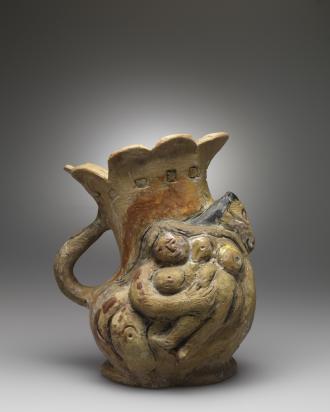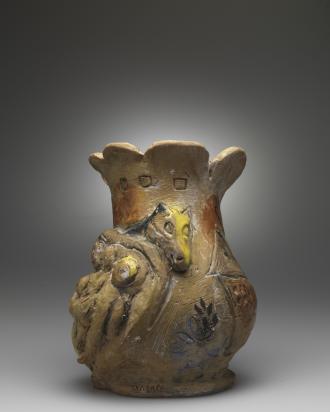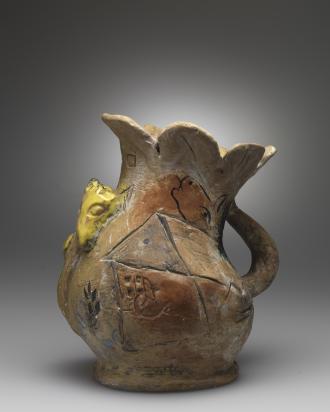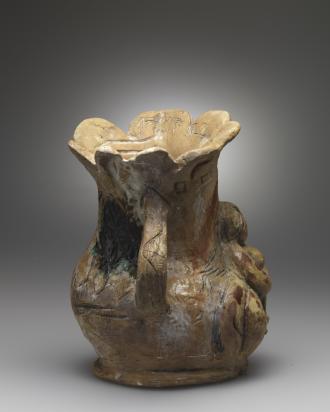The Flight into Egypt (1952) is one of Chagall's first hollow pieces, which he produced until 1962, with a brief resumption in the early 1970s. After creating about a hundred dishes with a variety of motifs and decorations, from 1951 Chagall tackled the third dimension through sculpture and ceramics, putting a new twist on the traditional forms of utilitarian and decorative pottery. This led to the "vase sculptures", one-off volume pieces produced at the Madoura studio whose diverse motifs and treatments reveal an insatiable curiosity and a deep attachment to the new medium.
Chagall usually featured Biblical motifs on dishes in his ceramic body of work. The Flight into Egypt is one of the few shaped pieces to draw its subject from the Old Testament. Chagall first depicted the story, a major iconographic theme in Western Christian art and a metaphor for exile, in a 1944 painting, echoing the tragic fate of Jews in Europe during the Second World War, before it resurfaced on a chamotte clay plate in 1951. He also featured the motif in a 1968-1969 marble sculpture and in several paintings in the 1970s. In choosing this theme, Chagall followed in the footsteps of the Old Masters he admired so much, such as Albrecht Dürer, Vittore Carpaccio, Titian and Nicolas Poussin, without losing his original and intimate reading of the holy story.
The artist set the wide-bodied jug in motion, pressing the central volume on the handle side and bulging on the opposite one, creating sinuous curves that welcome the Holy Family fleeing to Egypt to save the baby Jesus from the massacre ordered by King Herod. The composition, whose pastel sketch Chagall transposed with few changes, omits Joseph to focus on the motherly figure of the Virgin and Child, treated in volume and accompanied by a protective donkey, the artist's favorite animal. The other side of the piece features an engraved traditional Russian cottage, like a long-hoped-for shelter after exile. Here, Chagall combined incision and engraving with a knife and drypoint, techniques often found in his shaped pieces, with a matte surface. The neck, recalling medieval poly-lobed ceramics, seems to unfold like a corolla, with wide, open petals whose organic nature suggests a form of vitality. The shape of the vase also allows for a panoramic circular movement, creating a veritable figure of the perpetual path unfolding in space and time. Clay left unglazed evokes trodden soil and the return to the homeland, adding to the symbolic richness of the vase, which "is no longer subjugated to its function as a container but achieves the status of an autonomous object".
Ceramic
The Flight into Egypt
(Fuite en Egypte)
- No. C-182
- 1952
- Vase
- red ochre clay, decorated with slips and oxides, engraved with a knife and dry point needle, partially enameled with brush
- 11 13/16 in. (30 cm)
-
SignedChagall and dated 1952 underneath
Signed Chagall on the foot
- Pottery studio: Madoura
- Cincinnati Art Museum, Cincinnati, United States Of America, inv. 2008.13
Related works

Marc CHAGALL, Esquisse pour La Fuite en Egypte (Esquisse pour La Fuite en Egypte), 1952, 6 11/16 x 4 15/16 in. (17 x 12.6 cm), Private collection © Fabrice GOUSSET/ADAGP, Paris, 2025

Marc CHAGALL, Esquisse pour La Fuite en Egypte (Esquisse pour La Fuite en Egypte), circa 1952, 18 1/8 x 24 1/8 in. (46 x 61.2 cm), Private collection © ADAGP, Paris, 2025







